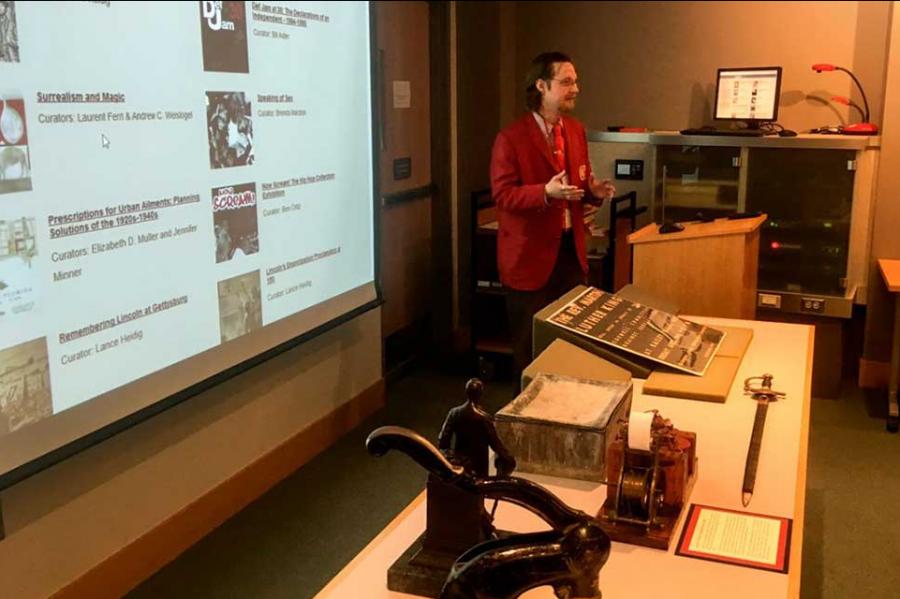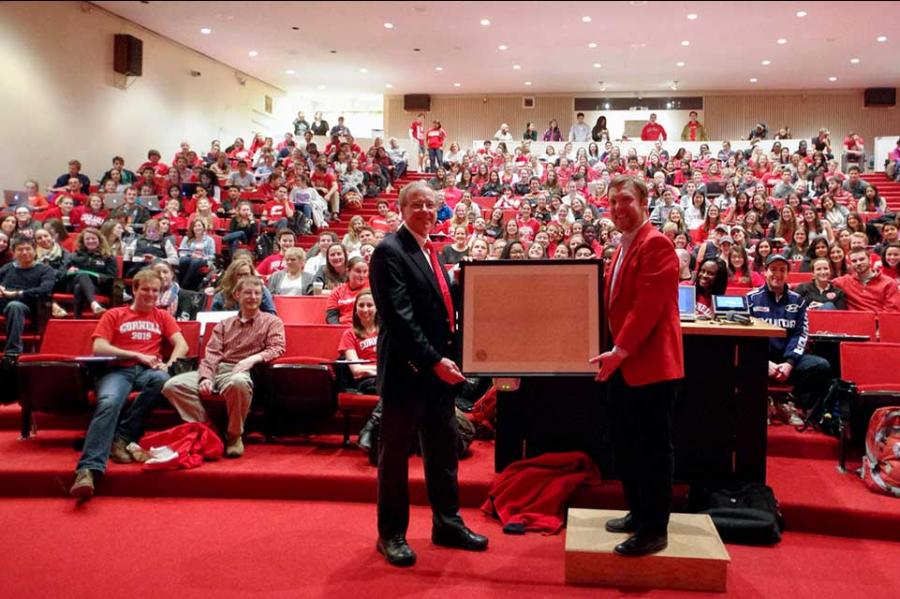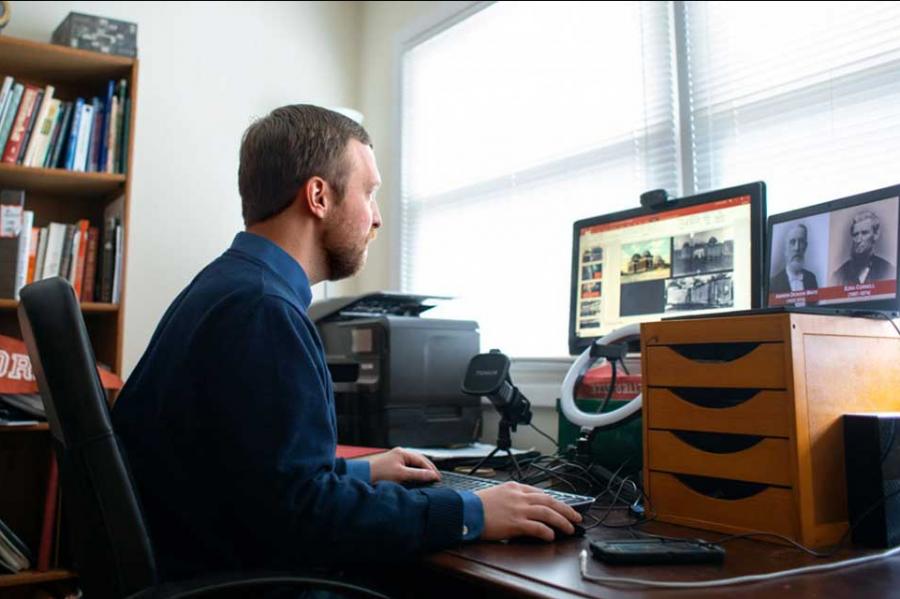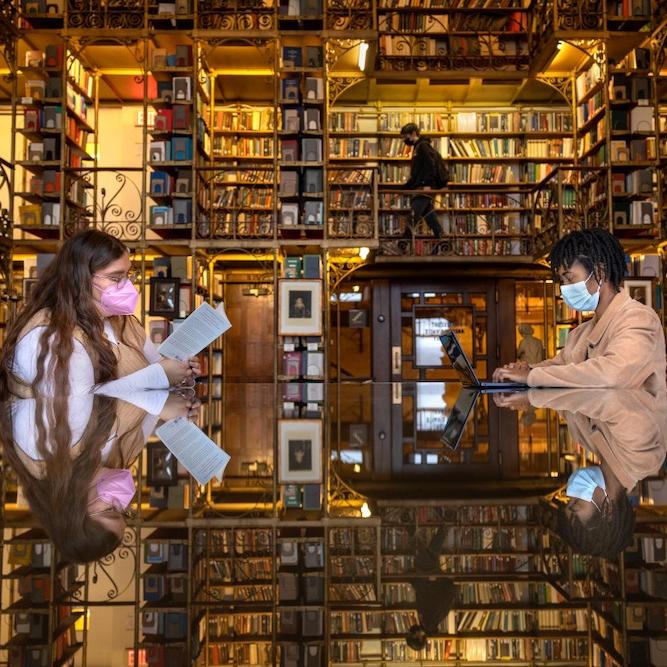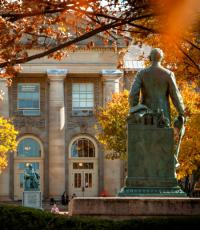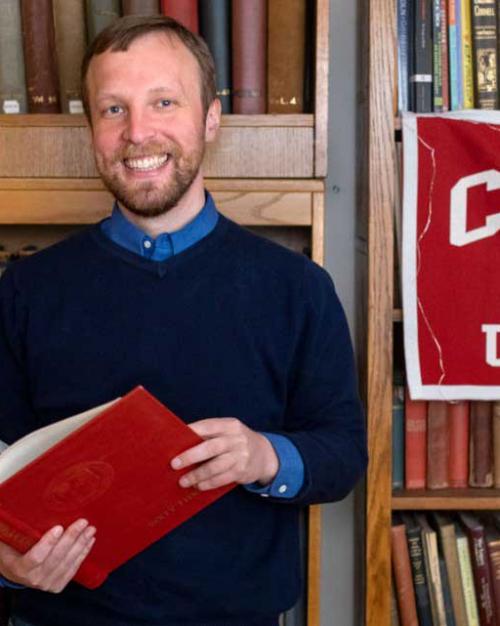When Corey Ryan Earle ’07 began teaching the Cornell history course The First American University (AMST 2001), he had several goals: to give Cornell students a deep understanding and shared appreciation for Cornell history; to explore the university’s pioneering “firsts” in U.S. higher education; and to know more about its most notable people, traditions and legacies.
But he didn’t anticipate it would create a multigenerational, international community, thousands of Cornellians strong, connected by their ties to the university – past, present and future.
“It became clear that students really appreciated learning more about where they were spending these years,” Earle said, “And that helps improve their sense of community and sense of belonging. And that’s really where the course came from – this idea of creating community for students, by learning more about this place and why it is the way it is.”
This spring marks 10 years since Earle began teaching The First American University. Its name comes from educational historian Frederick Rudolph, who, in a 1977 book, described Cornell as “the first American university” due to its unique role as a coeducational, nonsectarian, land-grant institution that offered a broad curriculum and enrolled a diverse student body.
Earle has crafted not merely a popular course that, for most of the past decade packed Uris Auditorium every Monday evening. It has also attracted a thriving following from students, faculty and staff across all colleges and units. A decade on, the course has produced a heightened understanding of the university’s history among students and a growing cadre of young alumni (as well as many older fans) who have a renewed appreciation for Cornell as a groundbreaking institution. The class also provides a contextual understanding of how the university’s principles, structure and history have shaped its past, informed its present and positioned it for the future.
Connections to history
Simon Boehme ’14 served as Earle’s first undergraduate assistant for the class in 2013 and 2014. When you’re a student, Boehme said, it can be difficult to grasp the context of Cornell’s history because “you’re often wrapped up in making your own history at Cornell,” he said. “You’re a part of groundbreaking research, creating something new, or learning how to fix a problem of yesterday. But when students stepped into Corey’s class, they could understand the people and actions that made it possible for Cornellians to create their own history.
“People discovered an even deeper love of Cornell and commitment to keep that groundbreaking, history-making spirit alive.”
When the COVID-19 pandemic hit in March 2020, the sudden closure of campus and subsequent shift to virtual classes gave Earle an unexpected opportunity to open the class to anyone who wanted to tune in. The virtual version of AMST 2001 extended the course’s reach and multigenerational fan base just as the need for community and connection had never been higher.
Linda Jarschauer Johnson ’60, M.S. ’63, began attending online soon after the pandemic hit and, this spring, began attending the class from the beginning.
“History teachers used to require memorization of dates and names, which was boring,” Johnson said. “Corey makes it fascinating by telling stories about students who walked the same streets, took similar classes, played pranks, and about the diverse faculty, who taught everything.”
Family ties set Big Red roots
Earle had always been a passionate aficionado and scholar of Cornell history. He became the 13th Cornellian in his family when he enrolled as an undergraduate with the Class of 2007; today, he is proud to be the fourth generation in his family to have both attended and taught at Cornell. His brother, Evan Earle ’02, M.S. ’14, is the Dr. Peter J. Thaler ’56 University Archivist. “We like to say, ‘He does the stuff and I do the story,” Corey Earle said.
When Earle was accepted to Cornell, he was given a copy of the Morris Bishop book “A History of Cornell.” “I was like, ‘Oh, there’s really interesting stories here – and most students have no idea about any of them,” Earle said.
He began sharing Cornell history by giving presentations and offering trivia games at Reunion events, the Cornell Alumni Leadership Conference, in residence halls and for student organizations. From summer 2009 he was on the university’s staff as associate director of student and young alumni programs.
Earle quickly realized that there was a great thirst and appreciation – by undergraduates especially – for not only a better working knowledge of Cornell history, but for a larger feeling of community to tie it all together.
Because Cornell is so large, with a spread-out campus and a vast diversity of subjects and students, students have few universal experiences, he said.
“You have Move-In Day and Slope Day and Commencement,” he said. “But for the most part, we’re a very decentralized university. And so it’s hard to have those shared experiences when you’ve got a bunch of your friends and classmates together.”
In 2016, Earle wrote an article, “Why a College Should Teach Its Own History,” that appeared in the Chronicle of Higher Education. He explained the unifying strategy and experience of AMST 2001 as “a large course with broad appeal across disciplines [that] offers students a unifying experience … It brings together engineers and athletes, pre-meds and humanists, first-generation students and fourth-generation legacies – students across fields of study and backgrounds, many of whom have never taken a course together. … An institution’s own history is a topic that can, and should, resonate with everyone. Students draw parallels with those of the past and are surprised by ways the undergraduate experience and the campus have changed.”
Earle created AMST 2001 with Thomas Balcerski ’05, M.A. ’11, Ph.D. ’14, then a graduate student in history; Balcerski helped get the course to a sponsoring faculty member, Shirley Samuels, professor of Literatures in English in the College of Arts and Sciences, and approved by the college.
The one-credit course covers university founder Ezra Cornell, first president Andrew Dickson White and the long, complex path to Cornell’s 1865 charter and creation; the development of the campus, the first colleges and the hiring of the faculty; the early commitment to diversity; and wartime at Cornell and the university’s long military connections. It also covers more contemporary topics such as unrest and student activism; the Ivy League and athletics; student life, pranks and traditions; the university’s administration and finances; Cornell in popular culture; and the future of the university. Weekly readings supplement the lectures and special guests, such as university trustee Ezra Cornell ’70, a direct descendant of the founder, make appearances.
Grading is based on attendance, one reading reflection, and one final project. Field trips to the university archives, Ithaca’s history center and other locations are offered for extra credit.
AMST 2001 has contributed to the university’s archives and furthered its understanding of its history. Students have written 1,579 research papers on hundreds of Cornell-related topics, from the impact of the Chinese Exclusion Act on the university to Ivy League fashion and Dr. Anthony Fauci, M.D. ’66. Students also have created a collection of scrapbooks for the archives (which are accessible to researchers) and interviewed 348 Cornellians (240 alumni, 69 faculty and 49 staff) for oral histories, going back to the Class of 1939.
Some students have been inspired to do even more. In 2015, Anisha Chopra ’13 and Alexander Bores ’13 began a new tradition, visiting Ezra Cornell’s birthplace on the founder’s Jan. 11 birthday, making a trip to the spot, which is now a McDonald’s in the Bronx. The pilgrimage has become an annual tradition for some dedicated AMST 2001 alums and students.
Don Horowitz ’77, who runs a nursery on Long Island, stopped by the class a couple of times in its first years when he was in town to deliver plants to the Department of Horticulture. He began stopping by several times a year – planning his campus visits to coincide with a Monday evening class – and, since the course moved online, he has been following regularly.
Horowitz noted the unique environment of the in-person, 400-strong class in Uris Auditorium on those evenings. “Students sitting in that large class seemed to have a great vibe, a sense of energy,” he said. “Willing to give up a Monday night, they wanted to be there.
“Learning some of that history – about the people and the place – have helped to make the university more personal for me,” Horowitz said. “Walking past a building and to know something about the person it’s named after became special. Corey’s honest assessment on some topics – not sugarcoating things – was, I felt, very important.”
Much of what Earle teaches in the course – fun trivia and pop culture connections, reexaminations of past events through a modern lens – isn’t in the history books. “Learning about prominent alumni accomplishments and discoveries, and more about Cornell history, has given me a greater sense of pride in the university,” Horowitz added.
Course evolves with the times
The course has developed over time, as new history is discovered, Earle said. “People often think of history as something that’s static, that’s already happened. But the way we understand and interpret that history does change.”
For example, over the last year, new scholarship about indigenous dispossession has emerged and connects to the Morrill Land-Grant Act and Cornell’s founding. “We’ve been able to use some of that new research to teach students about Cornell’s historic connections with indigenous communities,” Earle said.
He updates the pop culture aspects each year, and has added a lecture on student life issues like transportation, dining and housing and how those have changed over time.
And, for the past two years, Earle has added more detail about how the university handled past pandemics and their impact, such as the 1903 typhoid epidemic, 1918-19 influenza pandemic and 1957 flu epidemic.
That, of course, is in response to the continuing impacts of the COVID-19 pandemic. On Friday, March 13, 2020, Cornell announced that it was suspending classes for three weeks due to the pandemic. Even with courses on pause, Earle offered the class that following Monday night online as a “Cornell History Happy Hour.”
“I knew the students were feeling stressed and frazzled,” he said. “I sensed there was a need, even more, for community.”
That initial webinar, put together with just three days’ notice (at that time, Earle had never even given a presentation via Zoom before), drew more than 350 people.
Earle offered the happy hour the next two Monday evenings. When classes resumed (all online) in April, he decided to keep it open to all Cornellians. “I decided, we might as well keep this community going,” Earle said.
That spring, many Cornellians, suddenly home from college for the rest of the semester, tuned in to the course with their families, garnering Earle more multigenerational fans. About 400 students were enrolled that spring, but Earle saw more than 1,000 attending each weekly online session, which were advertised to alumni.
Earle also immediately saw the future significance of the pandemic’s early weeks; he added a new assignment that spring, giving enrolled students the chance to contribute directly to university archives by writing about their experiences during the pandemic. The project was a collaboration with Earle’s archivist brother, Evan, and with The History Center in Tompkins County.
Once the happy hours began, “my father – also a Cornellian – eagerly awaited each week’s riveting lecture,” recalled Caroline Harrison ’21. “After several weeks of hearing his rave reviews, I decided to pull up a chair and join him.”
Harrison’s father, by the way, is Bob Harrison ’76, chairman of the Cornell Board of Trustees.
“I’m a huge Corey fan,” Bob Harrison said. “I never cease to be amazed at the breadth and depth of his knowledge of all things Cornell – from the most consequential to the trivial. I wish a course like his existed when I was a student. It’s accessible to every Cornellian by tapping into a common set of experiences, and Corey has a style that is both substantive and entertaining.”
The virtual history happy hours were so popular with many Cornellians that, once the course officially resumed online in April 2020, Earle began receiving requests to present individual Zoom history sessions for groups and special events. So far, he has presented over 90 different Cornell history sessions on Zoom for events and organizations including Bring a Child to Work Day for Cornell Human Resources, the Cornell Retirees Association, Orientation, the President’s Council of Cornell Women, the Cornell Asian Alumni Association, CUGALA (Cornell’s LGBTQ Alumni Association), and many individual colleges, regional clubs, alumni classes, and student organizations.
AMST 2001 was offered fully online for the spring 2021 semester. Just under 1,000 students are officially enrolled, with more than 300 alumni tuning in and more than 50 parents and grandparents watching along with their students.
Overall, over the two semesters the class has been online, Earle has seen a total of more than 8,000 unique live attendees from 50 countries, from all U.S. states except South Dakota, and alumni from every class year from the 1940s to the present.
He has tried to replicate the interaction and sense of community that existed in Uris Auditorium by bringing in an alumni guest for part of each class. Guests in 2020 and 2021 have included university leaders such as President Martha E. Pollack and trustees Beth Anderson ’80 and Ezra Cornell ’70, as well as:
- Svante Myrick ’09, Ithaca city mayor;
- Frank Dawson ’72, co-director and co-producer of the film “Agents of Change” who participated in the Willard Straight Hall occupation in 1969 during his freshman year;
- four-time NCAA wrestling champion and two-time world champion Kyle Dake ’13;
- two-time Super Bowl winner Kevin Boothe ’05;
- comedian and actress Andrea Savage ’94;
- Mickey Rapkin ’00 (the movie “Pitch Perfect” was based on his book about collegiate a cappella);
- Academy Award-winning film producer Ryan Silbert ’02;
- Katy Cornell ’01, great-great-great-great-granddaughter of Ezra Cornell;
- John Rawlins ’06, Cornell Black Alumni Association president;
- Vernice Arahan '14, former Cornell Asian Alumni Association president;
- Meghan Frank ’11, vice president of the Dr. Konstantin Frank Winery;
- Robin Rosenbaum ’88, judge for the U.S. Court of Appeals for the 11th Circuit;
- Aaron Stehura ’09, M.Eng. ’10, flight system engineer for the NASA Perseverance Rover on Mars at NASA’s Jet Propulsion Laboratory;
- Nathan Connell ’01, former chair of the Cornell University Council;
- Corey Earle’s brother and university archivist Evan Earle ’02, M.S. ’14; and
- Marc Lacey ’87, assistant managing editor of The New York Times.
“I ask each guest to talk about how they’ve stayed connected with Cornell and what the Cornell community has meant to them,” Earle said. Cornell “is a lifetime experience. You’re connected with this community long after you graduate.”
“I’m still learning new things by following #AMST2001 on Twitter and oftentimes feel like I’m back sitting in the bright red chairs in Uris Hall,” said Boehme, who has founded and advised multiple legal tech companies since graduation. “I’m excited Cornell continues to make this class available to its students and hope one day, every student will take it to make their own bond with Cornell stronger and deeper.”
This story originally appeared in the spring 2021 issue of Ezra magazine.



